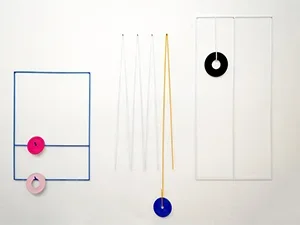Function and Color
When Brian Vu ’16 was a student at Bennington, he studied Dance and Ceramics, two complementary fields that appealed to him in physical and tangible ways.

“I took a ceramics course with Yoko Inoue during my second year. I currently throw ceramics, but I mainly casted my work during the beginning of my years at Bennington,” said Vu. “Dance was a natural field to transition into. Dance practices are built upon routines and training the body. Throwing also first involves repetition, then improvising and differentiating and finding new viewpoints and ideas.”
Vu, who recently completed his MFA in Ceramics at Cranbrook Academy of Art, returned to Bennington College in October 2019 for an artist residency supported by the Woodbury Foundation.
Following his own graduation from Bennington, Vu’s artistic career has taken him to a number of states. He first landed in Colorado, where he worked as an assistant to Kim Dickey, a ceramics professor at the University of Colorado-Boulder, before moving to Michigan to complete his MFA. Since then, Vu has been “residency hopping,” building his practice and participating in shows from Miami to Chicago to Minneapolis and more.
Most recently, Vu was the artist-in-residence at Ox-Bow School of Art, during which he began work on the pieces he used for his Woodbury residency installation at Bennington College.
“Ox-Bow gives artists-in-residence a lot of free reign to create,” said Vu. “Since graduate school, I’ve been formulating my approach to ceramics. I use functional objects as a reference point for the work, but it ultimately becomes non-functional. The objects become analogous to the domestic, which I then highlight through the use of color.”
Vu is particularly interested in experimenting with everyday functional ceramics pieces.
“Over the past ten years, I’ve lived so many different places,” said Vu. “Each time I set up my apartment or house, I use the same objects—my plates and cups maintain their same place on the table, even if the table changes. My practice as an artist also plays with this improvisation, rearranging similar objects throughout different spaces and exploring how saturated color can offset that mundanity.”
During his residency at Bennington, Vu continued his experimentation with color, but he also branched out into different forms and materials. The result was a solo exhibition, Plural Negative 10.19.2019., which was displayed at VAPA.
While at the College, Vu had the opportunity to meet and work with current Bennington students. Barry Bartlett, a close mentor during Vu’s time in college, invited Vu to guest teach and critique during one of his classes, Projects in Ceramics.
“I spent a day with Barry’s class critiquing students’ work, sharing my viewpoint, and providing feedback on their projects,” said Vu, who offered both group critiques and one-on-one sessions with students in Bartlett’s course. “Since I’m coming right out of graduate school, I’m still in an intensely academic mindset, so I understand where students are coming from. We had a lot of conversations around their processes and approaches to art, and I offered suggestions to push their work forward.”
Even outside the classroom, Vu connected with students as he worked alongside them in the wood shop, metal shop, and ceramics studio. In addition to talking about their work, Vu offered advice on how to pursue art as a career.
“I spoke with an international student who was trying to find a graduate school where they would be comfortable. Cranbrook has a high international student population, so we talked quite a bit about my experience there,” said Vu. “Through our conversation, Cranbrook also became an option for them.”
To current Bennington students interested in pursuing careers in art, Vu emphasizes the importance of both perseverance and networking.
“Maybe this advice sounds daunting, but being an artist is harder than you think, regardless of how prepared you think you are,” said Vu. “After college or graduate school, you make your own path, and no one is going to give you a rubric or syllabus for that. Everyone’s approach is different, but mine involves constantly applying for shows and residencies and networking with people. Keep in contact with your network—I’m still in touch with Barry, Yoko, and other teachers at Bennington, which has been important to me.”
Vu also credits his diverse Field Work Term experiences with helping him pick up life skills that have since come in handy.
“I worked for art galleries, dance companies, an ad agency where I did video and photo editing, and I did people’s taxes,” said Vu. “All of these Field Work Term oddities became useful in the end. Through them, I learned about the financial and practical side of running a gallery, how to balance working in different artist studios at the same time, and how to survive as a practicing artist.”
Going forward, Vu is intent on maintaining an interdisciplinary artistic path, in line with the philosophy he first developed at Bennington.
“At Bennington, everything is interconnected,” said Vu. “Cranbrook was a natural progression and fit for me, since I went from Bennington’s project-based courses to Cranbrook, which emphasizes studio practice and reflection.”
Vu is grateful, too, for his most recent time back on Bennington’s campus.
“I’ve accomplished so much in three weeks here,” said Vu. “It’s great to have a budget to make work, while also being housed and fed, and to be working in Bennington’s facilities, on top of all that. I’ve appreciated getting to reconnect here.”
By Natalie Redmond, Associate Writer